Documentary series on activism leverage captivating storytelling and consistent release schedules to enhance audience retention and engagement. By employing character-driven narratives and real-time event coverage, these series create emotional connections that deepen viewers’ understanding of critical social issues. Platforms like BBC iPlayer, Channel 4, and Netflix play a vital role in distributing these impactful stories, each offering unique advantages to reach diverse audiences.
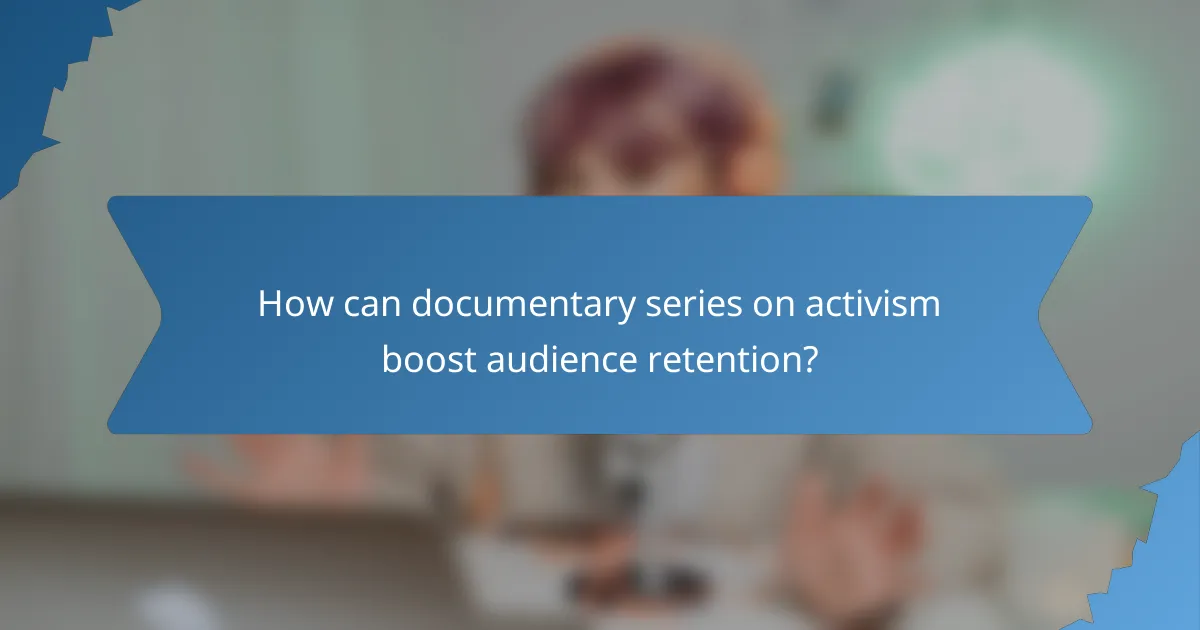
How can documentary series on activism boost audience retention?
Documentary series on activism can significantly enhance audience retention by employing captivating storytelling, fostering interactive participation, and adhering to consistent release schedules. These strategies create a compelling viewing experience that keeps audiences engaged and coming back for more.
Engaging storytelling techniques
Effective storytelling is crucial in documentary series about activism. Utilizing narrative arcs, character development, and emotional resonance helps viewers connect with the subject matter. For instance, following the journey of an activist can personalize the struggle and inspire empathy, making the content more memorable.
Incorporating diverse perspectives and real-life testimonials can also enrich the narrative. This approach not only provides depth but also showcases the multifaceted nature of activism, appealing to a wider audience. Visual elements, such as striking imagery and dynamic editing, further enhance engagement.
Interactive audience participation
Encouraging audience interaction can significantly boost retention rates. This can be achieved through social media engagement, live Q&A sessions, or dedicated online forums where viewers can discuss episodes and share their thoughts. Such interactions create a sense of community and investment in the content.
Incorporating polls or feedback mechanisms within the series can also help tailor future episodes to audience preferences. For example, asking viewers to vote on topics for upcoming episodes fosters a participatory culture that keeps audiences involved and eager for new content.
Consistent release schedules
Maintaining a consistent release schedule is vital for retaining audience interest in documentary series. Regularly scheduled episodes, whether weekly or bi-weekly, help establish a routine for viewers, making it easier for them to anticipate and engage with new content.
Additionally, releasing episodes in batches can create binge-watching opportunities, which may enhance viewer retention. However, it’s essential to balance the frequency of releases with the quality of content to ensure that each episode remains impactful and engaging.

What are effective episodic storytelling methods in activism documentaries?
Effective episodic storytelling methods in activism documentaries engage viewers by creating emotional connections and providing in-depth insights into social issues. Techniques such as character-driven narratives, real-time event coverage, and personal impact stories enhance audience retention and encourage a deeper understanding of the activism being portrayed.
Character-driven narratives
Character-driven narratives focus on individuals who are directly involved in the activism, allowing viewers to connect emotionally with their journeys. By showcasing personal struggles, motivations, and triumphs, these stories humanize complex issues and make them more relatable. For instance, following a grassroots organizer over several episodes can illustrate the challenges and victories faced in their fight for change.
To effectively use character-driven narratives, filmmakers should prioritize authenticity and depth. This can involve interviews, behind-the-scenes footage, and personal anecdotes that reveal the character’s background and aspirations. Engaging storytelling techniques, such as cliffhangers or evolving arcs, can keep audiences invested in the characters’ journeys.
Real-time event coverage
Real-time event coverage captures significant moments as they unfold, providing viewers with an immediate sense of urgency and relevance. This method can include protests, rallies, or legislative sessions, allowing audiences to witness activism in action. By presenting events as they happen, documentaries can create a visceral connection to the cause and highlight the stakes involved.
Filmmakers should consider the logistics of real-time coverage, including access to events and the ability to capture high-quality footage under pressure. It’s crucial to balance immediacy with context, ensuring that viewers understand the background and implications of the events being shown. This can be achieved through expert commentary or supplementary information presented alongside the footage.
Personal impact stories
Personal impact stories focus on the real-life effects of activism on individuals and communities, illustrating the tangible outcomes of social movements. These narratives can include testimonials from those directly affected by issues such as climate change, inequality, or human rights abuses. By highlighting personal experiences, these stories can evoke empathy and motivate viewers to take action.
To effectively convey personal impact stories, filmmakers should aim for emotional resonance and clarity. This can involve using a mix of interviews, visual storytelling, and statistics to paint a comprehensive picture of the issue at hand. Providing a call to action at the end of these stories can further encourage viewers to engage with the cause and support the activism being depicted.
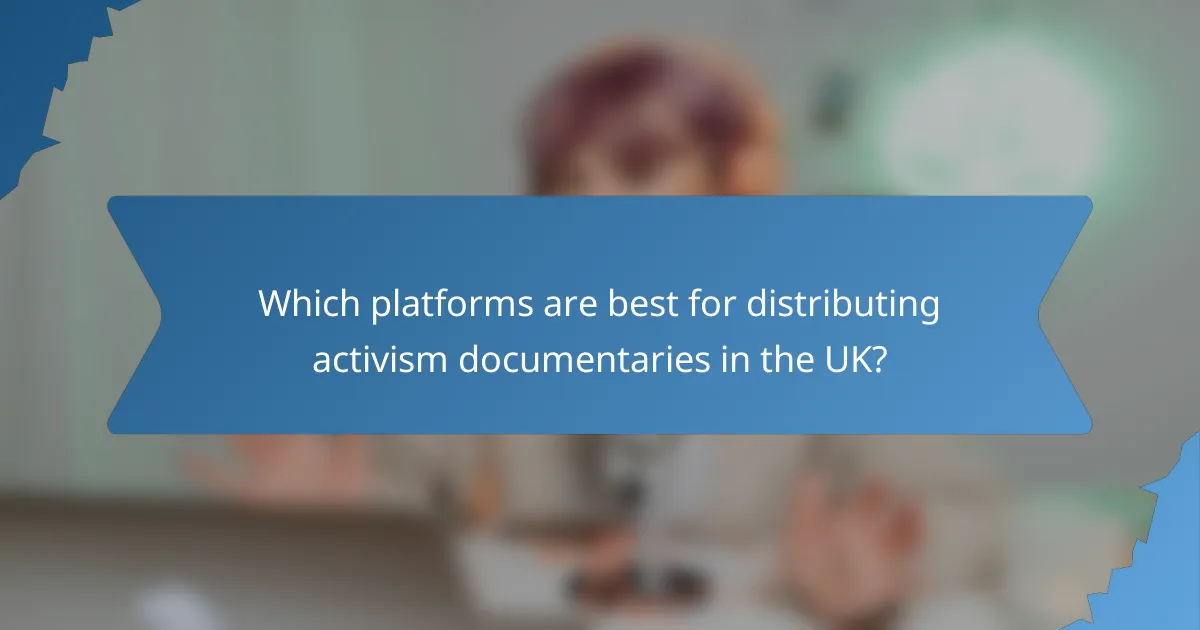
Which platforms are best for distributing activism documentaries in the UK?
For distributing activism documentaries in the UK, platforms like BBC iPlayer, Channel 4, and Netflix offer unique advantages. Each platform has its own audience reach, content guidelines, and distribution strategies that can significantly impact viewership and engagement.
BBC iPlayer
BBC iPlayer is a prominent platform for UK audiences, providing a wide range of documentaries, including those focused on activism. The platform is known for its strong commitment to public service broadcasting, which often prioritizes educational and socially relevant content.
To distribute on BBC iPlayer, creators must adhere to the BBC’s editorial guidelines, ensuring that the content is informative and engaging. The platform typically features a mix of original programming and acquired content, making it essential to pitch unique stories that resonate with its audience.
Channel 4
Channel 4 is another key player in the UK documentary landscape, known for its innovative and often provocative programming. It actively seeks out content that challenges societal norms and sparks conversation, making it an excellent choice for activism documentaries.
Producers should consider Channel 4’s focus on diverse voices and underrepresented stories when developing their projects. Submitting proposals that highlight unique perspectives can increase the chances of acceptance, as the channel aims to reflect the diversity of UK society.
Netflix
Netflix has rapidly become a global leader in documentary distribution, including activism-focused content. With its vast subscriber base, it offers significant exposure for filmmakers, but competition is intense, and content must stand out.
When pitching to Netflix, creators should focus on high production values and compelling narratives. The platform favors original content that can attract and retain viewers, so emphasizing unique angles or untold stories is crucial for success.
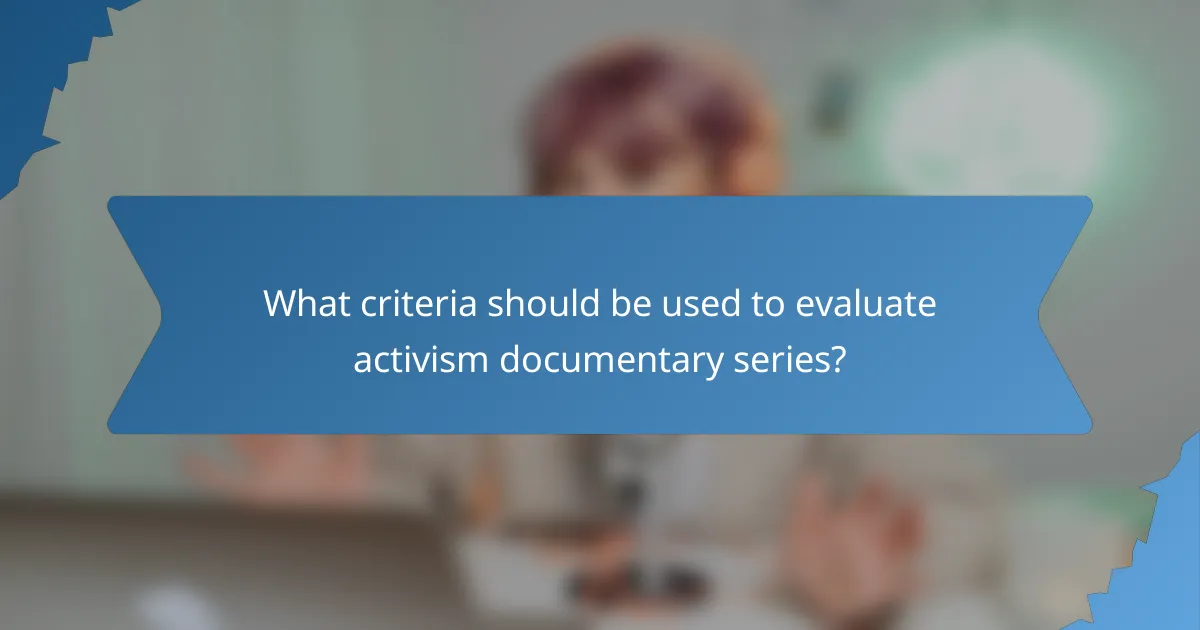
What criteria should be used to evaluate activism documentary series?
To evaluate activism documentary series, consider viewer engagement metrics, content diversity, and social impact assessment. These criteria help determine how effectively a series communicates its message and resonates with its audience.
Viewer engagement metrics
Viewer engagement metrics include factors such as audience retention rates, average watch time, and social media interactions. High retention rates indicate that viewers are captivated by the content, while strong social media interactions suggest that the series is prompting discussions and sharing among audiences.
To assess these metrics, platforms like YouTube and Vimeo provide analytics tools that track viewer behavior. Aim for retention rates above 50% and consider using interactive elements like polls or Q&A sessions to enhance engagement.
Content diversity
Content diversity refers to the variety of perspectives, themes, and storytelling techniques used in the documentary series. A diverse range of voices and narratives can enrich the viewing experience and appeal to a broader audience.
When evaluating content diversity, consider including different cultural viewpoints, various forms of activism, and multiple storytelling formats, such as interviews, animations, and archival footage. This approach not only attracts diverse viewers but also fosters a more comprehensive understanding of the issues presented.
Social impact assessment
Social impact assessment evaluates how effectively a documentary series influences public opinion, inspires action, or contributes to social change. This can be measured through surveys, feedback, and tracking changes in viewer behavior or community involvement following the series’ release.
To conduct a social impact assessment, gather qualitative data from viewers about their perceptions and actions after watching the series. Consider collaborating with organizations that focus on the issues covered to gauge the documentary’s real-world effects and to enhance credibility.
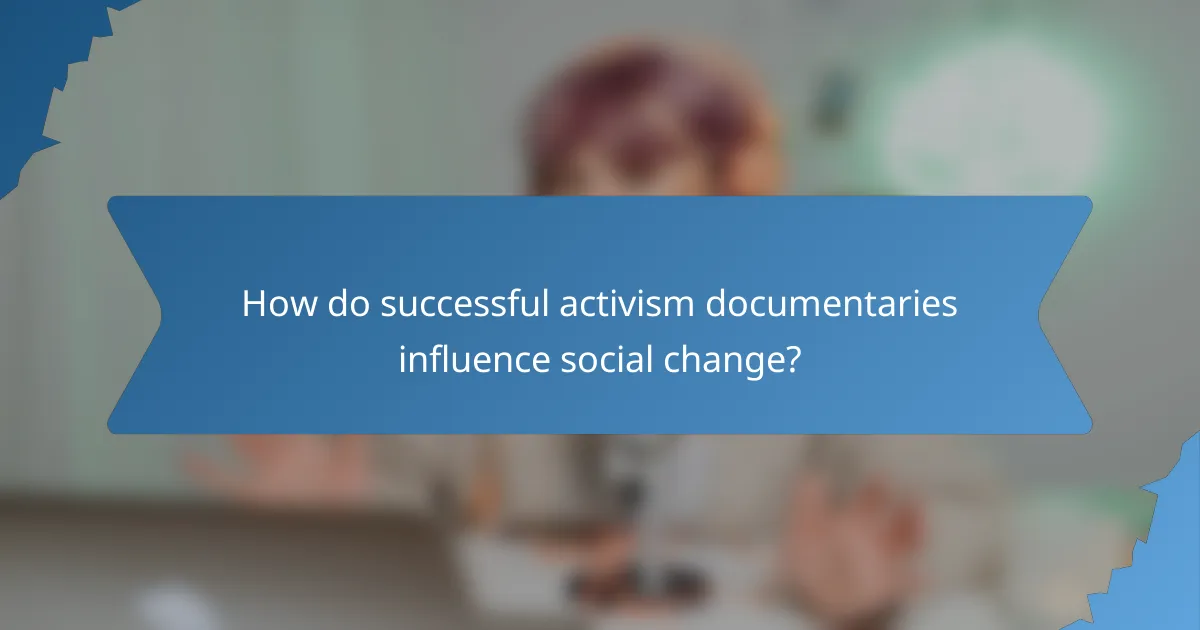
How do successful activism documentaries influence social change?
Successful activism documentaries influence social change by raising awareness, mobilizing communities, and shaping public policy. These films engage audiences emotionally and intellectually, prompting them to take action on critical issues.
Raising awareness
Activism documentaries effectively raise awareness by highlighting social issues that may be overlooked or misunderstood. By presenting compelling narratives and real-life stories, these films can spark conversations and encourage viewers to learn more about the topics presented.
For example, documentaries focusing on climate change often showcase personal stories of those affected by environmental disasters, making the issue more relatable and urgent. This emotional connection can lead to increased public interest and concern.
Mobilizing communities
Documentaries can mobilize communities by providing a platform for collective action and engagement. They often feature calls to action, encouraging viewers to participate in local initiatives or support specific movements. This can include attending rallies, signing petitions, or volunteering for organizations.
Community screenings of these films can further enhance mobilization efforts, as they create spaces for discussion and collaboration among like-minded individuals. By fostering a sense of community, documentaries can turn passive viewers into active participants in social change.
Shaping public policy
Activism documentaries can shape public policy by influencing public opinion and raising the profile of certain issues among policymakers. When a documentary gains traction, it can lead to increased media coverage, which in turn pressures legislators to address the highlighted concerns.
For instance, documentaries that expose injustices in the criminal justice system can lead to calls for reform, prompting lawmakers to consider changes in legislation. Engaging storytelling combined with factual evidence can make a compelling case for policy shifts, ultimately driving social change.
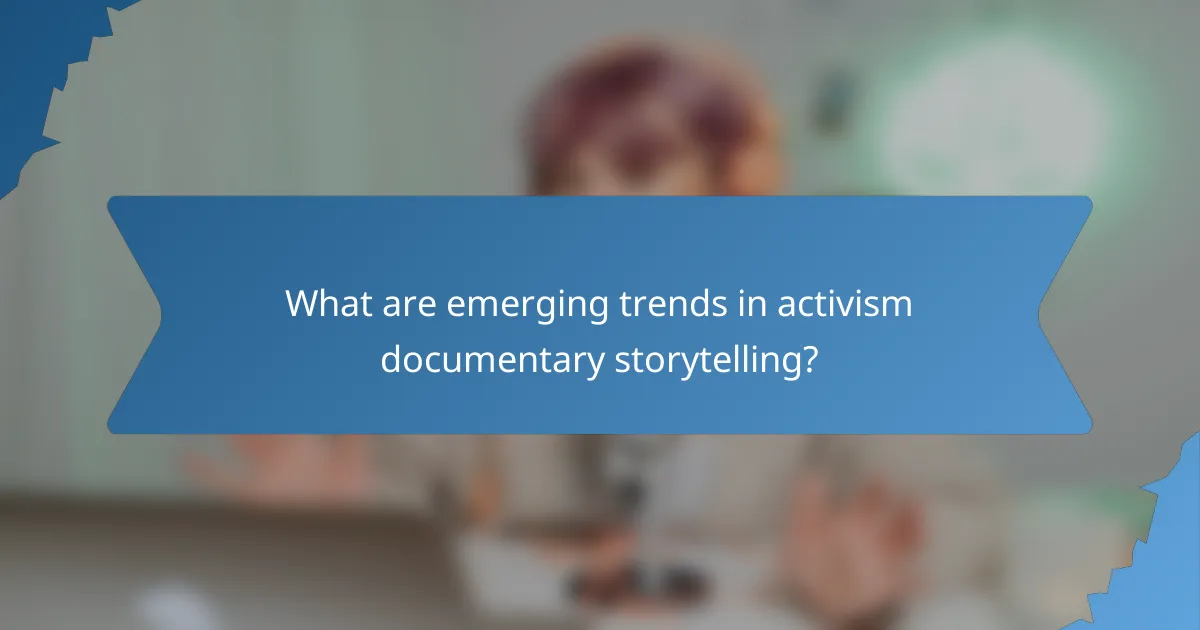
What are emerging trends in activism documentary storytelling?
Emerging trends in activism documentary storytelling focus on episodic formats, in-depth exploration of social issues, and strategies for enhancing audience retention. These trends reflect a growing demand for engaging narratives that not only inform but also inspire action.
Episodic storytelling in activism documentaries
Episodic storytelling allows filmmakers to break down complex social issues into digestible segments, making them more accessible to viewers. This format encourages deeper engagement as audiences can follow a narrative over multiple episodes, fostering a connection with the subject matter.
For instance, a series might explore climate change across several episodes, each focusing on different aspects such as policy, personal stories, and scientific insights. This structure keeps viewers invested and promotes ongoing discussions around the topics presented.
In-depth exploration of social issues
In-depth exploration is crucial for activism documentaries as it provides context and nuance to pressing social issues. Filmmakers are increasingly using thorough research and expert interviews to present a well-rounded view of topics, which enhances credibility and encourages informed dialogue.
Documentaries that delve into issues like racial justice or environmental sustainability often include personal narratives alongside expert analysis. This combination not only educates viewers but also humanizes the struggles faced by activists, making the content more relatable.
Strategies for audience retention
To retain audiences, activism documentaries are employing various strategies such as cliffhangers, interactive elements, and community engagement. Cliffhangers at the end of episodes can create anticipation for the next installment, while interactive elements like social media discussions can keep viewers engaged between episodes.
Additionally, fostering a sense of community around the documentary can enhance viewer loyalty. Filmmakers might encourage audience participation through online forums or events, allowing viewers to connect with each other and the issues presented, ultimately driving sustained interest in the series.
